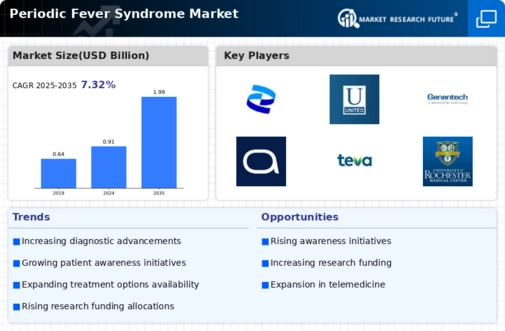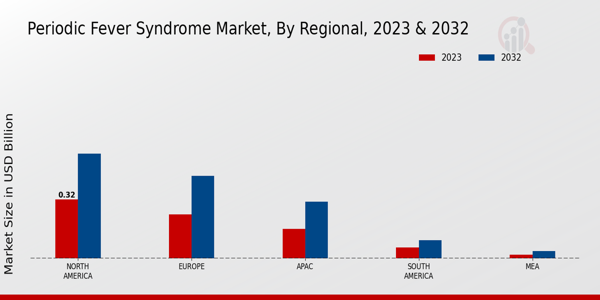Market Growth Projections
The Global Periodic Fever Syndrome Market Industry is projected to experience substantial growth over the coming years. With a market value of 0.91 USD Billion in 2024, it is anticipated to reach 1.99 USD Billion by 2035. This growth trajectory reflects a compound annual growth rate of 7.35% from 2025 to 2035, driven by various factors including increased awareness, advancements in diagnostics, and enhanced treatment options. The market's expansion is indicative of the growing recognition of Periodic Fever Syndrome and the need for effective management strategies.
Advancements in Diagnostic Techniques
Technological advancements in diagnostic methodologies are significantly influencing the Global Periodic Fever Syndrome Market Industry. Enhanced genetic testing and biomarker identification have improved the accuracy of diagnosing this complex syndrome. These innovations facilitate timely and precise identification of underlying causes, which is crucial for effective treatment. As the market evolves, the integration of advanced diagnostic tools is likely to enhance patient outcomes and drive market growth. The anticipated growth trajectory suggests that by 2035, the market could reach 1.99 USD Billion, reflecting the impact of these advancements.
Rising Awareness of Periodic Fever Syndrome
The increasing awareness of Periodic Fever Syndrome among healthcare professionals and patients is a pivotal driver for the Global Periodic Fever Syndrome Market Industry. Educational initiatives and advocacy from patient organizations have contributed to a better understanding of the condition, leading to earlier diagnosis and treatment. This heightened awareness is expected to result in a growing patient population seeking medical attention, thereby expanding the market. As of 2024, the market is valued at 0.91 USD Billion, indicating a robust demand for effective therapies and management strategies.
Growing Incidence of Auto-inflammatory Disorders
The rising incidence of auto-inflammatory disorders, including Periodic Fever Syndrome, is a notable driver for the Global Periodic Fever Syndrome Market Industry. As the prevalence of these conditions increases, there is a corresponding demand for effective treatment options. This trend is compounded by the growing recognition of the importance of managing chronic inflammatory conditions. The market's growth is expected to be robust, with projections indicating a rise to 1.99 USD Billion by 2035, as healthcare systems adapt to address the needs of this expanding patient population.
Increasing Investment in Research and Development
Investment in research and development within the Global Periodic Fever Syndrome Market Industry is a critical driver of growth. Pharmaceutical companies and research institutions are focusing on developing novel therapies and treatment protocols for this syndrome. This investment not only fosters innovation but also enhances the understanding of the disease mechanisms, potentially leading to breakthroughs in treatment. With a projected compound annual growth rate of 7.35% from 2025 to 2035, the market is poised for significant expansion, driven by these R&D efforts.
Enhanced Treatment Options and Therapeutic Advances
The development of enhanced treatment options and therapeutic advances is significantly shaping the Global Periodic Fever Syndrome Market Industry. New therapies, including biologics and targeted treatments, are emerging, offering improved efficacy and safety profiles for patients. These advancements are likely to lead to better management of symptoms and improved quality of life for individuals affected by the syndrome. As the market continues to evolve, the introduction of innovative therapies is expected to contribute to the overall growth, aligning with the projected market value of 0.91 USD Billion in 2024.















